Introduction
Fall is a beautiful time of year. It’s impossible not to recognize the beauty of the leaves changing colors, but have you ever stopped to think about why the leaves are changing colors? There is something significant happening. Since there is not as much daylight and temperatures are dropping, the leaves cannot produce enough food for their trees. Knowing that winter is coming, trees will absorb the remaining nutrients from their leaves. These nutrients are needed so trees do not waste energy during the winter, which is why trees can survive the changing seasons.
Leaders experience season changes all of the time. There are seasons where it seems that everything is going well; relationships are great, tasks are being completed, there’s organizational growth, and we feel successful. Then there are seasons where it seems that everything is going wrong. Relationships are deteriorating, there is not enough time to get tasks done, we are uncertain about the organization’s or our team’s direction, and we may even question our ability to lead. Whatever season we find ourselves in, we need to have practices that will help us thrive or, at the very least, survive the season.
Preparing for Season Changes
Just like a tree preparing for winter, leaders should have routine self-care practices for their survival during challenging seasons. Self-care is necessary for all people to live and lead well. This is true in all seasons but is especially important during difficult seasons. The problem is that self-care practices are not always prioritized and made a routine. We are all guilty of starting a self-care practice and then stopping it after a short time. James Clear, the author of Atomic Habits, discussed ways in which people can establish new habits through a process called habit stacking. Establishing a self-care practice may be the thing that fuels your survival during difficult seasons. Here are the ways you can develop your new habit:
- Identify the new habit: Think about what self-care practices you have engaged in previously that you found beneficial or a new one that you would like to try out. Take some time to experiment with a couple different ones. You must be specific. If you want to practice a gratitude reflection each day, then specify how long you want this reflection to last. Once you have identified the new habit, it’s time to take a look at your schedule.
- Identify pre-established habits: What habits do you practice on a daily basis? Maybe it is making coffee in the morning, driving to and from work, or taking a lunch break. The important thing is that you identify a habit that you do every day. Consider whether or not the established habit can be paired with your new one. If so, then you are ready to move on to step three.
- Stack your new habit: Now it is time to practice habit stacking. You will simply stack the new habit on top of the pre-established one. For example, your new habit may be taking five minutes to reflect on what you are thankful for. Since you already make coffee every morning, practice your gratitude reflection as soon as you press start on the coffee machine. When you do this, your brain is more likely to adopt the new habit. Since the new habit is being stacked on an existing one, your brain is already programmed to remind you to do half of the work. Now it is a matter of sticking with your new practice.
Reflection to Action: What self-care practice would be beneficial for me in all seasons of leadership? Utilize habit stacking to make this identified self-care practice a routine.


















